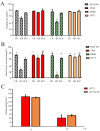Optimization of γ-Aminobutyric Acid Production in Brown Rice via Prolonged Seed Priming
- PMID: 39771293
- PMCID: PMC11677616
- DOI: 10.3390/plants13243594
Optimization of γ-Aminobutyric Acid Production in Brown Rice via Prolonged Seed Priming
Abstract
Germinated whole seeds possess elevated levels of bioactive nutrients; however, their application is hindered by several constraints. The germination process is typically time-consuming, and germinated seeds present challenges in terms of storage and transportation compared to dry seeds. This study introduces a novel processing method for rice, termed prolonged priming (PLP), aiming to combine the benefits of germinated and dry seeds. PLP involves soaking the seeds until the embryo exposure stage, followed by redrying. At 10 h (hour) germination post PLP, the γ-aminobutyric acid (GABA) levels in Hanyou73 (HY73) and IRAT exceeded 20 mg/100 g. Additionally, there was an induction of various nutrient components, including an increase in protein content, a reduction in amylose levels, and an elevation in fatty acid content, among others. Malondialdehyde levels, indicating oxidative damage, remained stable, and PLP preserved better seed integrity compared to routine priming in the desiccation-tolerant HY73. Collectively, the PLP treatment demonstrates an optimization of the nutritional value and storage in germinated brown rice (GBR). This novel process holds potential for enhancing the nutritional profile of GBR and may be applicable to other crop species.
Keywords: desiccation tolerance; germinated brown rice; prolonged priming; routine priming; seed integrity; γ-aminobutyric acid.
Conflict of interest statement
The authors declare no conflicts of interest.
Figures






Similar articles
-
Increased γ-Aminobutyric Acid Content of Germinated Brown Rice Produced in Membrane Reactor.Food Technol Biotechnol. 2021 Sep;59(3):295-305. doi: 10.17113/ftb.59.03.21.6846. Food Technol Biotechnol. 2021. PMID: 34759761 Free PMC article.
-
Germinated brown rice as a value added rice product: A review.J Food Sci Technol. 2011 Dec;48(6):661-7. doi: 10.1007/s13197-011-0232-4. Epub 2011 Jan 22. J Food Sci Technol. 2011. PMID: 23572802 Free PMC article.
-
Effects of cyclic cellulase conditioning and germination treatment on the γ-aminobutyric acid content and the cooking and taste qualities of germinated brown rice.Food Chem. 2019 Aug 15;289:232-239. doi: 10.1016/j.foodchem.2019.03.034. Epub 2019 Mar 13. Food Chem. 2019. PMID: 30955607
-
Germinated brown rice and its bio-functional compounds.Food Chem. 2016 Apr 1;196:259-71. doi: 10.1016/j.foodchem.2015.09.025. Epub 2015 Sep 9. Food Chem. 2016. PMID: 26593491 Review.
-
Germinated brown rice and its role in human health.Crit Rev Food Sci Nutr. 2013;53(5):451-63. doi: 10.1080/10408398.2010.542259. Crit Rev Food Sci Nutr. 2013. PMID: 23391013 Review.
Cited by
-
The Effect of Different Processing Methods on Metabolite Profiles by Comparative Metabolomics in Kernels and Sprouted Seeds of Foxtail Millet.Foods. 2025 May 27;14(11):1900. doi: 10.3390/foods14111900. Foods. 2025. PMID: 40509427 Free PMC article.
References
-
- Idowu A.T., Olatunde O.O., Adekoya A.E., Idowu S. Germination: An alternative source to promote phytonutrients in edible seeds. Food Qual. Saf. 2020;4:129–133. doi: 10.1093/fqsafe/fyz043. - DOI
-
- Garg M., Sharma A., Vats S., Tiwari V., Kumari A., Mishra V., Krishania M. Vitamins in Cereals: A Critical Review of Content, Health Effects, Processing Losses, Bioaccessibility, Fortification, and Biofortification Strategies for Their Improvement. Front. Nutr. 2021;8:586815. doi: 10.3389/fnut.2021.586815. - DOI - PMC - PubMed
Grants and funding
LinkOut - more resources
Full Text Sources
Research Materials

